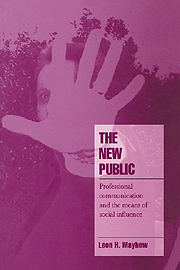Book contents
- Frontmatter
- Contents
- Preface
- Part I Rhetoric and the integration of society
- Part II Influence
- 3 Influence: capacity to persuade
- 4 Habermas and Parsons: critical issues regarding influence
- 5 Public influence: a new paradigm
- 6 The differentiation of rhetorical solidarity
- Part III The New Public
- Notes
- References
- Index
3 - Influence: capacity to persuade
Published online by Cambridge University Press: 06 September 2009
- Frontmatter
- Contents
- Preface
- Part I Rhetoric and the integration of society
- Part II Influence
- 3 Influence: capacity to persuade
- 4 Habermas and Parsons: critical issues regarding influence
- 5 Public influence: a new paradigm
- 6 The differentiation of rhetorical solidarity
- Part III The New Public
- Notes
- References
- Index
Summary
The New Public is constituted by the rise of professional experts on persuasion. These experts aspire to more than particular acts of persuasion; they aim to build, and to help others to build, the general capacity to persuade that we call influence. Understanding the New Public and assessing its consequences therefore requires establishing a frame for thinking about the sources and uses of influence.
As public cynicism creeps into daily usage, the words, “rhetoric” and “influence” take on pejorative connotations. “Rhetoric,” which once meant using words to urge to action has come to mean using words instead of action. “Influence,” which once meant swaying by persuasive argument or by invoking trust, rather than by exercising power, is now used to label the power employed by insiders. In this usage, influence refers to fixing traffic tickets, or blocking legislation, or keeping names out of the newspaper. Such conflation of terms may simply reflect the fuzzy boundaries of categories of action in daily life, but failure to make clear distinctions obscures the diversity of ways that citizens affect each other's beliefs and conduct. Influence and power are analytically different processes. When an official's job is threatened if favors are withheld, this is an exercise of power, not influence. When a newspaper editorial changes people's opinions, or when a political speech affects how people vote, or when a public demonstration calls attention to a social cause, thereby signaling to others a measure of public support for that cause, that is influence.
To possess influence is to hold or to have access to resources of persuasion so that influence can be exercised on a regular basis across a broad range of situations.
- Type
- Chapter
- Information
- The New PublicProfessional Communication and the Means of Social Influence, pp. 51 - 80Publisher: Cambridge University PressPrint publication year: 1997



